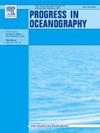Seasonal variations of the cold intermediate layer on the Newfoundland and Labrador Shelf
IF 3.6
3区 地球科学
Q1 OCEANOGRAPHY
引用次数: 0
Abstract
Across the Newfoundland and Labrador (NL) continental shelf, sub-surface temperatures remain below 0°C throughout the summer, when the surface is much warmer. This oceanographic feature is known as a cold intermediate layer (CIL), and its properties are assessed annually in the region to support ocean climate research and fisheries management. Monitoring in this region is either too infrequent or too sparse spatially to provide a detailed picture of sub-annual variations, so the GLORYS12 global ocean reanalysis is used for this purpose. GLORYS12 is shown to reproduce both the signs and magnitudes of inter-annual variations in CIL area on NL Shelf transects, although the magnitude of the seasonal cycle may be under-estimated.
GLORYS12 indicates that sub-zero water volume is maximized across the region during March and decreases with time, beginning in the south and proceeding north. CIL minima are reached between November to December at most shelf locations, proceeding in the opposite direction. Stratification triggered by surface freshwater is an important contributor to CIL seasonal changes on all transects on the NL Shelf. While the CIL area tends to gradually erode throughout the summer, the downstream advection of CIL water from more northern transects leads to the development of secondary CIL area maxima during late August to early September on the Newfoundland component of the shelf. Onshore intrusions either at the shelf break or via cross-shelf troughs contribute to the erosion of CIL area from below at some transects, although this effect may be exaggerated in the model.
纽芬兰和拉布拉多大陆架寒冷中间层的季节性变化
在整个纽芬兰和拉布拉多(NL)大陆架上,整个夏季的次表层温度都保持在 0°C 以下,而此时的表层温度要高得多。这一海洋特征被称为寒冷中间层(CIL),该地区每年都要对其特性进行评估,以支持海洋气候研究和渔业管理。对这一区域的监测要么过于频繁,要么过于稀疏,无法提供次年变化的详细情况,因此为此使用了 GLORYS12 全球海洋再分析。GLORYS12 显示,整个地区的零度以下水量在 3 月份达到最大,并随着时间的推移从南向北逐渐减少。11 月至 12 月间,大多数陆架地点的 CIL 达到最小值,并向相反方向递减。在北大西洋大陆架的所有横断面上,表层淡水引发的分层是造成 CIL 季节性变化的重要原因。虽然 CIL 区域在整个夏季趋于逐渐侵蚀,但来自更北横断面的 CIL 水的下游平流导致纽芬兰陆架部分在 8 月底至 9 月初形成次级 CIL 区域最大值。陆架断裂处的陆上入侵或通过跨陆架槽的入侵,在某些横断面上造成了自下而上的 CIL 面积侵蚀,尽管这种影响在模型中可能被夸大了。
本文章由计算机程序翻译,如有差异,请以英文原文为准。
求助全文
约1分钟内获得全文
求助全文
来源期刊

Progress in Oceanography
地学-海洋学
CiteScore
7.20
自引率
4.90%
发文量
138
审稿时长
3 months
期刊介绍:
Progress in Oceanography publishes the longer, more comprehensive papers that most oceanographers feel are necessary, on occasion, to do justice to their work. Contributions are generally either a review of an aspect of oceanography or a treatise on an expanding oceanographic subject. The articles cover the entire spectrum of disciplines within the science of oceanography. Occasionally volumes are devoted to collections of papers and conference proceedings of exceptional interest. Essential reading for all oceanographers.
 求助内容:
求助内容: 应助结果提醒方式:
应助结果提醒方式:


